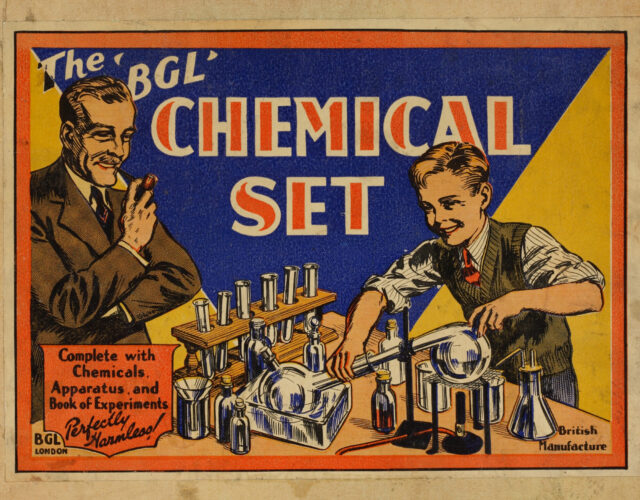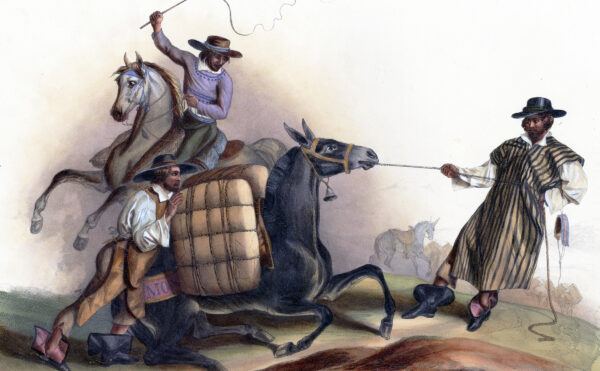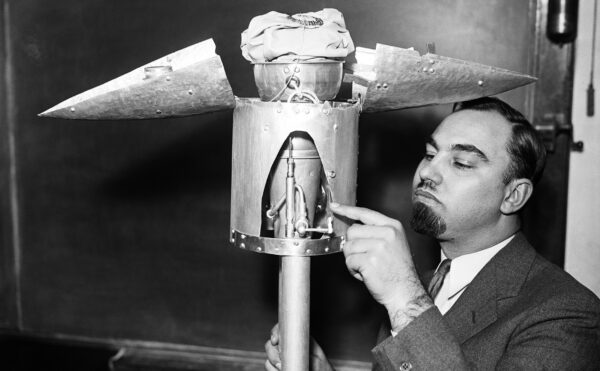In 2003, in The Chemcraft Story, author John Tyler claimed that today’s chemists rated a battered and stained modern chemistry-set manual from their childhood more highly than one of the foundation stones of chemistry—Robert Boyle’s 17th-century Skeptical Chymist. How did a toy manual come to displace one of chemical history’s most important books in the minds of chemists?
Chemistry sets were never just toys. Over the years they have been tied to the status of science. Parents saw in them building blocks for a chemistry career, while post–World War II educators found a valuable cold war tool. Later, regulators worried about safety as society took note of the dangers posed by science. Chemistry sets showcased the high value attached to science and suffered when science fell from grace. Today science is once again in the public eye, and chemistry sets are back.
One of the first chemistry sets, or portable chemical chests, is mentioned in Johann Friedrich Göttling’s 1791 text, Description of a Portable Chest of Chemistry or a Complete Collection of Chemical Tests. Originally printed in German, the chests were for use by “Chemists, Physicians, Mineralogists, Metallurgists, Scientific Artists, Manufacturers, Farmers, and the Cultivators of Natural Philosophy.” The contents included glassware, reagents, and a blowpipe. The tests or experiments are basic and provided a firm foundation for those studying the science.
In 1797 James Woodhouse, a professor at what is now the University of Pennsylvania in Philadelphia, wrote the Young Chemists Pocket Companion, his own volume of chemical experiments connected with a portable laboratory. The experiments in Göttling’s and Woodhouse’s works are similar, with a few slight variations in technique and approach. The audience, though, had changed; Woodhouse noted on his title page that he created his Companion and chest for the use of ladies and gentlemen, not just scientists.
Around the same time, chemist Friedrich Accum, best known for his battle against food adulteration, also described experiments for portable chemistry chests. His kits contained at least twice the number of experiments as did Woodhouse’s and Göttling’s and were arranged by the material being tested; all gas experiments in one section, all water experiments in another, and so forth. Accum intended his works only for chemistry students and professionals. Advertisements placed in the front of Accum’s books remind the reader to buy materials at his London shop. In a time of limited advertising, such notices were the only way—aside from word of mouth—companies and dealers could tell people about their products.
Göttling, Woodhouse, and Accum capitalized on the broad popularity science enjoyed by the beginning of the 19th century. Widely publicized public lectures and demonstrations attracted both the elite and the common. Some of the most prestigious scientists of the day, including Michael Faraday and Humphry Davy, became public figures in their own right and frequently gave public demonstrations of their research.
In part, chemistry’s widespread popularity during this time can be attributed to Jane Marcet’s Conversations on Chemistry. First published in England in 1805 and in the United States in 1806, Conversations on Chemistry went through many editions. During the conversations Mrs. B, the main character, demonstrates concepts using simple terms and familiar everyday circumstances. Following Marcet’s lead, people like Mary Townsend, Elizabeth Cady Agassiz, and Reverend J. L. Blake all wrote hugely popular science texts in the same conversational format.
Chests similar to those described by Woodhouse and Göttling, and books like Marcet’s, continued to be produced and marketed through the middle of the 19th century. But in the 1860s a new company entered the market, creating new marketing techniques and new audiences. At its height John J. Griffin and Sons manufactured and sold 11 different categories of chemical cabinets, ranging from simple ones for the merely curious or beginning students to specific cabinets required by colleges and universities throughout England. Specific sets were offered for students attending the Royal Naval College, the Royal Agricultural College, Oxford University, and Cambridge University, as well as sets specifically manufactured for elementary school headmasters. The diversity of the Griffin sets ensured their dominance. Until the late 1940s no other brand of chemical chest was as popular.
Production of chemistry sets declined leading into World War I, after Germany, then the largest producer of raw chemicals, stopped exporting. In England and France governments diverted the limited amount of domestic chemical production to war uses, leaving companies like Griffin without sufficient chemicals for their sets.
As tensions rose in Europe, a small company was born in 1914 in Hagerstown, Maryland. Porter Chemical Company’s goal was to make and sell “chemical preparations and other materials and articles.” Company founders, brothers John J. and Harold Mitchell Porter, chose to concentrate on chemistry sets for their ease of manufacture and because they provided one of the few intellectually stimulating toys for children.
Mainly focusing on the mid-Atlantic cities of Philadelphia, Baltimore, and Washington, D.C., the first of Porter’s Chemcraft sets appeared in 1915 and quickly gained immense popularity. The sets soon found their way onto the shelves of chain stores like Woolworth and Strawbridge and Clothier. The first Chemcraft line only included two or three types of sets with one standard booklet. But as their popularity with children grew, so did the number of sets offered. In any given year during the 1950s, Porter offered between 10 and 15 different sets that ranged in size from 10 pieces to more than 100, and in price, starting at $1.
In 1920 a rival emerged. Alfred Carlton Gilbert, inventor of the hugely popular Erector Set, began selling simple microscope and Chemical Magic sets. These first kits included instructions on how to put on “magic” shows using the experiments and chemicals provided. Shrinking, melting, changing colors, and disappearing were all effects used to amuse. Warren Schlinger, a chemical engineer, recalls, “One day, [my friend] Keith got a Gilbert Chemistry Set. He invited me over . . . and we did every experiment in the book. I was fascinated.” George Rathmann, cofounder of biotech giant Amgen concurs: “You find out that you can take a metal . . . put it in water and . . . blow up the hydrogen that’s being generated, and then you find it can be sodium or it can be potassium or it can be lithium!”
Over the course of the next 30 years Porter and Gilbert competed in an expanding market. They vied for buyers and advertising space, usually in comic books, Popular Science, and other magazines aimed at children. The two companies even competed in the designs of the sets, each not wanting to be too similar to the other and each wanting to be more colorful and eye-catching. After World War II, Porter and Gilbert were joined by other brands, such as Skil-Craft, Handy-Andy, and Midget Lab, new companies intent on capitalizing on the increasing popularity of this toy.
The first sets were housed in either cardboard or painted wooden boxes. Subsequent sets had aluminum or tin cases painted in bright colors with images of boys playing with test tubes and other pieces of lab equipment. Later sets included images of rockets, satellites, and submarines, and so-called atomic sets depicted images of cooling towers and the universal symbol of the atom.
Set contents were fairly similar from company to company and included an instruction book, a test-tube rack, a simple balance, an alcohol lamp, and a variety of chemicals. “It upset my family to no end … the smells and the things that I used to make in the basement,” says former Gordon Research Conference director Carlyle Storm about his Gilbert chemistry set. Later additions included complex microscopes and even the occasional spinthariscope—a device used to see the “waves of radiation” emitted by the accompanying sample of depleted uranium dust.
The emergence of Porter and Gilbert with their unique marketing strategy opened the chemistry set to an entirely new market. Children had frequently been a favorite target of stores, which knew the influence they held over their parents’ purse strings. But Porter and Gilbert hit upon something new. They marketed the kits in two distinct ways: to children as toys, but to parents as an educational gateway to a possible career. The Chemcraft corporate slogan at this time, “Experimenter Today . . . Scientist Tomorrow,” perfectly embodies this idea. The impact was not lost on kids like Schlinger, Rathmann, and Storm, all of whom grew up to become noted chemists.
In the mid-1950s a second focus emerged—the idea of world leadership and global responsibility through science. The dawn of the nuclear age and the race for space presented big issues needing big solutions. As a result the public began to expect more of chemistry and other sciences. Program developers—usually academic and industrial chemists and physicists—for Gilbert, Porter, and the other companies decided that children needed grounding in more complicated topics like fusion and fission and even quantum mechanics. Abstract cover art and Chemcraft’s new slogan, “Porter Science Prepares Young America for World Leadership,” captured this shift.
Sets specifically marketed for girls did not emerge until the late 1950s. Called Lab Technician Sets, they contained little more than a plastic microscope and prepared slides. Pink boxes showed girls working with other girls. This gender barrier on set covers continued through the mid- to late 1960s, after which boys and girls were shown working together, usually “supervised” by a professional chemist in a white lab coat.
The emergence of the “supervisor” on the front of sets marked the beginning of another fundamental shift by companies to emphasize the safety of their products. By the mid-1960s increasing safety concerns resulted in many toys being deemed too dangerous for children. Parents no longer wanted their children playing with loose chemicals or bending glass with an alcohol lamp in the basement. Gilbert and Chemcraft even put labels on the front of their sets, assuring parents that they had passed safety tests and contained nontoxic, nonexplosive chemicals.
Beginning with the Federal Hazardous Substances Labeling Act of 1960, government regulation of chemicals fundamentally changed the makeup of chemistry sets and limited the experiments possible. Any material considered flammable, toxic, explosive, or caustic, or to be an irritant or a strong sensitizer required labeling. Gone were hydrochloric and sulfuric acids and alcohol lamps.
President Richard Nixon signed the Toy Safety Act in 1969, which created the first American safety standards for toys. The Department of Health, Education, and Welfare was now charged with testing and regulating (including banning) all toys sold in the United States.
In 1972 the newly created Consumer Product Safety Commission began setting safety standards, forcing companies to answer questions about what chemistry sets contained and why. Was it appropriate to teach children how to bend glass or to make gases using acids? What were the chances of injury or of setting a house on fire? Previously, Gilbert and Porter answered only to their customers and advisers; now they answered to commissioners untrained in science. The Toxic Substances Control Act, passed in 1976, added further limits, banning some chemicals outright, while regulating the amounts in which others could be obtained. The act also required companies selling chemicals to keep a record of who purchased what and in what quantities.
With increasing regulation and the dilution of both chemicals and experiments, the popularity of chemistry sets faded. Experiment booklets diminished from more than 100 pages to 25 to 30 pages of simple, safe, and routine experiments. Both Porter and Gilbert went out of business—Gilbert in 1967 and Porter in 1984.
Another factor in the chemistry set’s decline was the changing public view of science, specifically chemistry. In 1962 Rachel Carson’s Silent Spring brought the prevalence and effects of pesticides to worldwide attention. Air pollution proved a potent source of concern in cities like Los Angeles and New York. Devastating limb deformities caused by the anti–morning sickness drug Thalidomide further influenced public views of chemistry. As the word chemistry in chemistry sets shifted from positive to negative in the minds of parents and children, demand faded.
In the late 1980s, with a resurgence in public interest in science, these educational toys reemerged. Public opinion on science, specifically chemistry and physics, had changed dramatically. New challenges like AIDS, cancer, over-farming, and the need for new materials drove the renewed influence of science. And an increase in scientific literacy helped: most students in the United States had the opportunity to take both chemistry and physics.
With a few exceptions today’s sets are smaller, less flashy, and contain fewer chemicals. Many sets boast of no chemicals at all. But they do attract children to science in creative ways. Large institutions like National Geographic, the Smithsonian Institution, and Cambridge University all either produce their own branded sets or endorse those produced by others. The draw of Harry Potter, kitchen chemistry, and “grossology” are undeniable from a marketing point of view. New computer and Web-based components create an interactive chemistry set suitable for children of the 21st century.
The 21st century, like the cold war, has its share of scientific challenges—global warming, alternative energy, health care, and the development of new drugs. Only through recreating the excitement present during the golden age of the chemistry set will we again find the enthusiasm children now often dedicate to computer games. As George Rathmann says of his early passion for chemistry sets, “Good lord! You’re suddenly catapulted into just the most exciting dimensions.”
In the past few years the chemistry set has reemerged. Thames and Kosmos sets best resemble those from the 1950s and include a number of enticing features—most notably real glassware and many of the chemicals necessary to conduct the suggested experiments (minus a few items like hydrochloric and sulfuric acids). Its CHEM series chemistry sets range in size and sophistication, starting at the CHEM C500—“perfect for children ages 8 and up who want a fun, welcoming tour of the science but aren’t ready for a complete chemistry set”—and peaking with the CHEM C3000, whose 172-page manual contains 387 individual experiments.
In my opinion the most intriguing part of these sets is the manual. It not only details the experiments themselves but also a number of other features that improve on the 1950s’ manuals and help bring the sets into compliance with modern regulations. Six pages in the introduction are dedicated to warning parents and the experimenter of the dangers associated with the chemicals and experiments. Later, an entire section provides instructions on how to properly dispose of completed experiments.
Like others from the past, the Thames and Kosmos manuals are arranged by subject, with each section increasing in difficulty as it builds on previously learned techniques. However, unlike previous manuals, these experiments are presented in a more conversational manner, similar to the works of popular 19th-century author Jane Marcet, and seek to engage the experimenter in a form of dialogue. In the CHEM C1000 and C2000 sets a character named Professor Probenius serves as a guide. Throughout the manual the experimenter answers questions similar to those found at the end of textbook chapters. This arrangement of the sections, which fosters engagement with the subject, mirrors the formal teaching of chemistry and other sciences and prepares the experimenter for further encounters with chemistry.
Another positive addition to these modern manuals is the historical context behind the subjects and techniques discussed. For example, in the section titled “Atoms—the Chemist’s Building Blocks” the first part discusses the development of the atomic theory and introduces Democritus and John Dalton. Also mentioned are Antoine Lavoisier, Friedrich Wöhler, August Kekulé von Stradonitz, the Hindenburg disaster, and alchemy. Along with the high points of chemistry the manual also includes discussions of more sensitive topics, such as the environmental impact of acid rain, air and water pollution, toxic waste, and resource depletion, which are addressed in a scientific way. By including discussions of history and modern issues, the Thames and Kosmos manual provides the experimenter with a fair and balanced—although admittedly condensed—view of the “real” field of chemistry.
While the CHEM series chemistry sets are on the expensive side, with the C3000 topping out at $240, the advanced sets are worth the investment to encourage a child with a serious interest in chemistry. However, additional options from Thames and Kosmos and other manufacturers exist for those just developing an interest in science or who simply enjoy science for recreation. Available for $40 and under, these general sets usually focus on either a single theme within a science or provide an overview of a number of different sciences. For example, the Mega Science Lab from the Smithsonian ($29.95) includes in its six components a weather station, an eco-dome habitat, and a crystal-growing kit. Meant as a general introduction to all aspects of science, these broader-based kits, as well as those focusing on grossology, makeup, perfume, the kitchen, and similar themes, are wonderful options for encouraging an interest in science without overwhelming the user.




